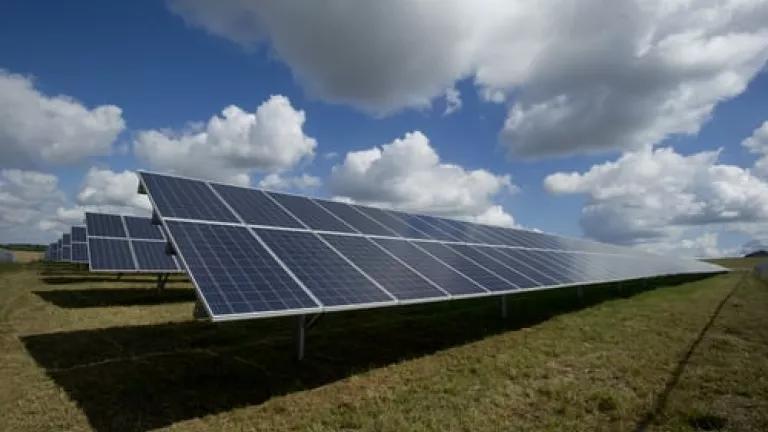New York PSC Issues Two Important Clean Energy Orders

In the midst of an unprecedented health crisis, New York’s commitment to tackling climate change and achieving a clean energy economy remains as steadfast as ever. Under Governor Cuomo’s leadership, the state recently enacted the Accelerated Renewable Energy Growth and Community Benefit Act (Accelerated Renewables Act), which will greatly expedite renewable energy generation and transmission projects and help ensure that the Climate Leadership and Community Protection Act’s (CLCPA) bold goals are met—including 70 percent renewable electricity by 2030, 100 percent clean electricity by 2040, and 6 gigawatts of distributed solar by 2025.
Breaking It Down
The New York State Public Service Commission (PSC) recently issued two orders to ensure that the state remains on track to meet these goals:
- Power Grid Study: First, the Commission issued an order directing the Department of Public Service to commence a proceeding to conduct a power grid study, as required by the Accelerated Renewables Act, to determine which upgrades must be made to the state’s transmission and distribution systems (i.e. the power lines and other infrastructure that deliver electricity to consumers) to achieve the CLCPA goals. Specifically, the study will identify necessary upgrades to existing local transmission and distribution infrastructure located in each utility’s service territory in New York. Utilities are required to file preliminary study results by August and complete the study by November. In addition to identifying necessary upgrades, the final study will include recommendations for integrating these upgrades into utilities’ ongoing capital programs.
- Process for determining transmission investments: Second, the order also requires utilities to develop proposals for a process that will guide future transmission investments. Specifically, the Commission wants utilities to address the following topics:
- Ensuing a transparent planning process
- Accounting for CLCPA benefits in utilities’ planning and investment criteria
- Ensuring that recommended projects are completed within the applicable CLCPA time frames
- Evaluating the benefits and costs (referred to as a “benefit-cost analysis”) of potential transmission investments
- Determining who should pay for the costs of these investments (referred to as “cost allocation methodologies”). With respect to this last item, the Commission pointed out that there is currently no method of recovering costs from certain upgrades that may address a specific CLCPA goal (like reduced greenhouse gas emissions). Issues that must be addressed in determining such a method of cost recovery include defining the benefits of such a project and developing mechanisms for recovering costs from those customers who receive those benefits. These proposals are due in early October, after which interested stakeholders will have an opportunity to comment on them.
- Plan for upgrading NY’s bulk power system: Third, the order also points out that the Accelerated Renewables Act requires that the Commission develop a plan for upgrading the state’s bulk power system (i.e. the power plants, transmission lines, and associated control equipment that generate electricity and deliver it to certain areas where it is then distributed to customers) based on the results of the power grid study. The order therefore directs DPS to initiate a second proceeding in the near future to establish criteria for bulk transmission planning and investments necessary to meet CLCPA requirements, and directs DPS staff to identify key issues that must be resolved, including scheduling and prioritizing projects and determining a method to fund these investments.
Implications for NY Sun
The second order extends New York’s successful NY Sun program through 2025. As I wrote here, NY Sun, which was created by Governor Cuomo in 2014, has provided necessary financing for almost 1,000 MW of solar projects—and another 1,000 MW is forthcoming.
Last November, NYSERDA filed a petition with the PSC seeking an additional $573 million to extend the NY-Sun program through 2025 (it was scheduled to end in 2023), which is critical because the CLCPA includes a goal of 6,000 MW of distributed solar by this date, a more than doubling of the amount that currently exists today.
Importantly, NYSERDA’s petition proposed to use more than a quarter of these funds to expand programs focused on low-to-moderate income (LMI) customers as part of a new Framework for Solar Energy Equity. Among other things, the Framework envisions an expansion of NYSERDA’s Solar for All program, which provides no-cost community solar to low-income households. It would also provide incentives for projects sited on affordable housing, LMI homeowners who install rooftop solar, and projects that pair solar with energy storage.
The order grants the petition and directs that initial funding from the expansion of the program comes from existing uncommitted funds held by NYSERDA, with extra funding to come from a review of Clean Energy Fund monies.
New York State is making clear that it’s in a league of its own when it comes to tackling climate change and ramping up clean energy. Over the past several years, under Governor Cuomo’s leadership, New York has taken sweeping steps toward creating a healthier, cleaner future. The Commission’s latest orders show that the momentum won’t be slowing anytime soon, and New York appears more than willing to do what it takes to lead on climate and meet its aggressive energy agenda.



